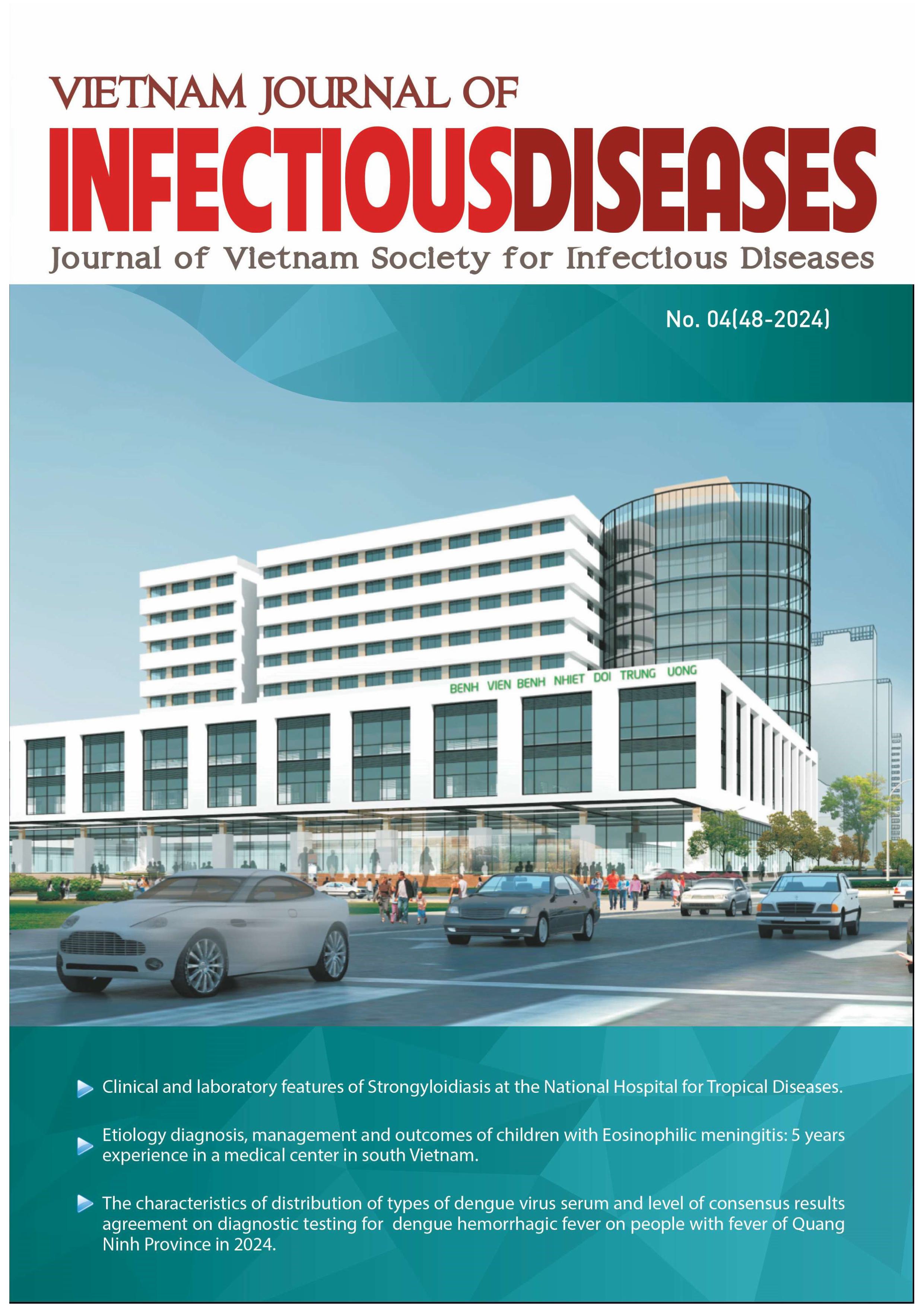CHARACTERISTICS OF SOME BACTERIAL PATHOGENS ISOLATED FROM THE PATIENTS WITH VENTILATOR-ASSOCIATED PNEUMONIA AT THE NATIONAL HOSPITAL OF TROPICAL DISEASES IN 2023
Nội dung chính của bài viết
Tóm tắt
Objectives: To describe the characteristics of some bacterial pathogens isolated from patients with ventilator-associated pneumonia (VAP) at the National Hospital for Tropical Diseases (NHTD) in 2023.
Subjects and methods: A cross-sectional, retrospective study was conducted on 176 medical records of patients with ventilator-associated pneumonia at NHTD who had bacterial culture results from January 2023 to December 2023.
Results: The incidence of VAP in male patients was 56.8%, while in female patients it was 43.2%. The average age was 59.6 years. The average time to identify VAP was 7.6 days, and over 80% of patients had underlying medical conditions. The most common causative agent of VAP was Acinetobacter baumannii (40.3%), while the least common was Acinetobacter pittii (0.3%).
Conclusions: The incidence of VAP in male patients (56.8%) was higher than in female patients (43.2%). The average age of the study subjects was 59.6 years, with an average VAP identification time of 7.6 days, and over 80% of the patients had underlying medical conditions. The most common pathogens causing VAP included Acinetobacter baumannii, Pseudomonas aeruginosa, and Klebsiella pneumoniae, accounting for 40.3%, 18.4%, and 16.5%, respectively.
Chi tiết bài viết
Từ khóa
Bacterial pathogens, ventilator-associated pneumonia, National Hospital for Tropical Diseases
Tài liệu tham khảo
2. Ministry of Health. Decision No. 3671/QDBYT dated September 27, 2012 of the Ministry of Health “Guidelines for prevention of hospitalacquired pneumonia in medical examination and treatment facilities (2012).
3. Hunter JD. Ventilator associated pneumonia. Postgrad Med J. 2006 Mar;82(965):172-8.
4. Etiology and treatment outcomes of patients with ventilator-associated pneumonia in the intensive care unit, Central Hospital for Tropical Diseases [Internet]. [cited 2024 Jan 24]. Available from:
https://truyennhiemvietnam.vn/ index. php/ vjid/article/view/242/194.
5. Microbial etiology and antibiotic resistance in patients with ventilator-associated pneumonia treated at the intensive care unit of Thanh Hoa General Hospital [Internet]. [cited 2024 Jan 24]. Available from: https://tapchiyhocvietnam. vn/index.php/vmj/article/view/3358/3096.
6. Bassetti M, Mularoni A, Giacobbe DR, Castaldo N, Vena A. New Antibiotics for HospitalAcquired Pneumonia and Ventilator-Associated
Pneumonia. Semin Respir Crit Care Med. 2022 Apr;43(2):280-94.
7. Nolley EP, Sahetya SK, Hochberg CH, Hossen S, Hager DN, Brower RG, et al. Outcomes Among Mechanically Ventilated Patients With Severe
Pneumonia and Acute Hypoxemic Respiratory Failure From SARS-CoV-2 and Other Etiologies. JAMA Netw Open. 2023 Jan 10;6(1):e2250401.
8. Yen NTH, Thao NT, Huong TT. Clinical characteristics of ventilator-associated pneumonia in the intensive care and anti-poison department
of Nam Dinh provincial general hospital. Vietnam Journal of Medicine [Internet]. 2024 Jul 22 [cited 2024 Aug 24];540(3). Available from: https://tapchiyhocvietnam.vn/index.php/vmj/article/view/10520.
9. Tram QA, Ha NT. Some bacterial characteristics of patients with ventilator-associated pneumonia in the anti-poison department of Nghe
An general hospital. Vietnam Journal of Medicine [Internet]. 2023 Sep 18 [cited 2024 Aug 24];530(1). Available from: https://tapchiyhocvietnam.vn/index.php/vmj/article/view/6599.
10. Bonell A, Azarrafiy R, Huong VTL, Viet TL, Phu VD, Dat VQ, et al. A Systematic Review and Meta-analysis of Ventilator-associated Pneumonia in Adults in Asia: An Analysis. of National Income Level on Incidence and Etiology. Clin Infect Dis. 2019 Jan 18;68(3):511-8.
11. Papazian L, Klompas M, Luyt CE. Ventilatorassociated pneumonia in adults: a narrative review. Intensive Care Med. 2020 May 1;46(5):888-906.


